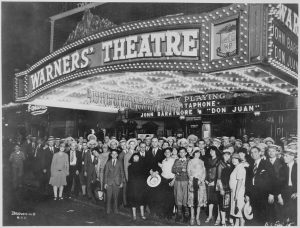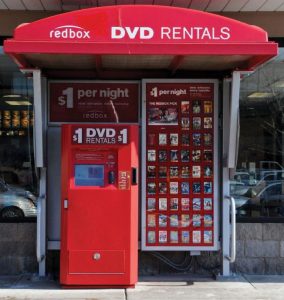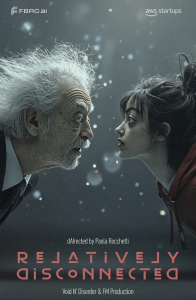14 Movies
By Alyssa Riley
Cinema has been a constant source of fascination for me, with films such as Interstellar, Parasite, Whiplash and the complete Harry Potter series among my all-time favorites. Yet these cinematic gems are a tiny slice of more than 500,000 movies that have graced the big screens since the creation of the first film in 1888. The movie industry evolved from technological breakthroughs in photography, the exploration of motion illusion, and the study of human and animal locomotion during its early era.

Movie-watching is one of my pastimes. I can be transported into different lives, breathtaking stories and other worlds. Sometimes I feel as though I know the characters on a personal level.
In the slightly over two decades of my life, the cinematic landscape has gone through a remarkable transformation. Visual quality has improved significantly, animation has become more lifelike, and advancements in green-screen technology and computer-generated graphics have expanded creative possibilities.
And it all began over 130 years ago with one invention capable of capturing moving images, forever altering the future of entertainment. In this chapter, I’ll take you through the history of the movie industry, from inventions and innovations to cultural persuasion through film.
YOUR MEDIA LANDSCAPE
Some textbooks suggest that movies remain the most immersive media experience for consumers, meaning we are more likely to pay attention and less likely to seek distractions when we are watching a movie.
Is this true for you in a movie theater? Is it true for you in other settings where you watch movies?
19th CENTURY: EARLY INVENTIONS
The pre-classical era of cinema started with the invention of the Kinetoscope, but there were subsequent innovations that steered the industry toward what we know today. The following slideshow summarizes the earliest technologies in the development of cinema:
Study the following presentation slides by using the forward button or clicking on sections of the control bar. To enlarge any interactive presentation in this book, click on the lower-right full-screen option (arrows).
Next, watch the following video for a more in-depth look at pre-classical cinema:
Thanks to YouTube, you can watch one of the first science-fiction movies ever made: A Trip to the Moon, directed by Georges Méliès. This may help you appreciate production techniques for silent films when there was no dialogue to further a movie’s plot.
The 2011 movie Hugo, directed by Martin Scorsese, includes scenes based on the work of Georges Méliès. The video below is cued to start at one of the scenes that may help you envision how A Trip to the Moon was made.
1900s: THE MOVIE INDUSTRY
Early in the 20th century, movies began changing rapidly. Films became more narrative in nature and included color and sound. Production companies popped up, and Hollywood emerged as the unofficial capital of the U.S. movie industry.
Motion Picture Theaters
Edwin S. Porter, a projectionist and engineer for the Edison Company, created The Great Train Robbery (1903), utilizing Méliès’ stage-like composition style through editing, camera pans, rear projections and diagonally composed shots. Establishing the realistic narrative as a new cinema standard, The Great Train Robbery can be considered the first major box-office hit and paved the way for industry growth. The video below is cued to start with a robbery scene.
Production Companies
With a surge in demand for movies, production companies gained prominence. The Motion Picture Patents Company (MPPC) was created in 1908. It pooled the most significant motion picture patents and established an exclusive contract between the 10 leading companies and Eastman Kodak Company, a supplier of film stock. By 1910, there were at least 20 production companies in the United States.
The Art of Silent Film
U.S. films gained popularity in Europe, Russia and Scandinavia from 1911 to 1926, as movies became longer and had more editing and production value for narrative-driven dramas, romances and comedies. With the use of phonographic cylinders and discs, music and soundtracks could be played as background sound in films.
Technicolor
Color was initially brought to films through hand coloring, tinting, toning and stenciling. But beginning in the early 1900s, the British Kinemacolor process – with principles of color separation – began to be used for “natural color’” moving images. Because the technicolor process was expensive and tedious, it was mostly used for documentaries from 1915 until 1932, when the three-color (red, green and blue) technicolor process was introduced. Classic films like Gone With the Wind and The Wizard of Oz (1939) were among the first to implement technicolor for broad audiences.
1920s-1950s: THE BRIGHT AND SHINY HOLLYWOOD
The Rise of the Hollywood Studios
When the stock market crashed and the Great Depression began, most of the country was hit hard. An exception, however, was the Hollywood movie industry.
In 1927, The Jazz Singer became the first feature-length film to have synchronized dialogue. By the early 1930s, a majority of feature-length films had sound, and by the mid-‘30s, some had full color, too. American film companies now dominated the worldwide industry as five major studios reigned supreme with only one real rival: India.

The Golden Age of Hollywood, or the rise of the Hollywood studios, came in the ‘30s, ‘40s and ’50s as cinema became the primary form of popular entertainment. Many Americans began visiting the cinemas at least two times a week. At the start of World War II, and gains in technology, production values improved. Also during World War II, the U.S. government sought help from Hollywood movie studios in creating films with patriotic content.
Appropriate Content and Codes
The Motion Picture Association of America (MPAA) was formed in 1922 to combat government censorship and promote artistic freedom and self-regulation through a rating system. By 1930, criticisms resurfaced, and conservative groups called for censorship. As a result, the Motion Picture Production Code, sometimes called “The Hays Code” for MPAA President Will H. Hays, was implemented. It remained in place until 1967 to ensure movies were “directly responsible for spiritual or moral progress, for higher types of social life, and for much correct thinking.”
You can watch the following video to learn more about the Golden Age of Hollywood:
An important legal side note from this era came in 1948. The U.S. Supreme Court ruled that movie studios could not have absolute control over which theaters would show their movies.
Prior to this ruling, major film studios often owned the theaters where their movies were shown. Formally titled United States v. Paramount Pictures, Inc., it also came to be known as the Hollywood Antitrust Case of 1948. If not for this ruling, you can imagine a U.S. movie landscape, decades later, in which moviegoers who wanted to seeToy Story and Finding Nemo could have only seen those Pixar movies in cities that had a Pixar-owned theater.
1960s-1980s: YOUTH CULTURE AND THE START OF SEQUELS
The Graduate, released in 1967, was one of the first U.S. films to reflect the attitudes of a younger generation, whom we now call Baby Boomers. Many Baby Boomers were dissatisfied with the repressive social codes established by older conservatives as well as U.S. participation in the Korean and Vietnam wars. In that same year, Bonnie and Clyde featured resistance toward patriotism and institutional authority.
Below is the 1967 trailer for The Graduate.
A New Ratings System
You may recognize these movie terms:
- G for general audiences
- PG for parental guidance suggested
- PG-13 for parents strongly cautioned
- R for restricted
- NC-17 for adults only
Established by the Motion Picture Association (MPA) in 1968, the Film Rating System was created to label movies and help parents determine the appropriateness of a film for their children.
Before these labels were introduced, parents across the nation were calling for government action to censor movies. Jack Valenti, then CEO of MPAA, listened to the concerns and established the Classification and Rating Administration (CARA).
CARA is composed of parents who rate 600 to 900 films a year to help other parents make informed decisions on what is appropriate for children of various ages to view. Additionally, CARA continuously engages with parents to consider changes in their attitudes. Here are a few brief facts about the MPAA’s Film Rating System:
- In 1984, ‘PG-13’ was introduced.
- In the ‘90s, rating descriptors were included for movies ‘PG’ or higher.
- In 2007, tobacco imagery was included as a rating factor.
- By the end of 2023, more than 28,000 films had been rated under the MPAA.
Blockbusters, Knockoffs and Sequels
The dawn of the modern film industry – including blockbusters, knockoffs and sequels – came in the ‘70s with a new wave of directors, many of whom explored digital and computerized special effects. Star Wars (1977), directed by George Lucas, was historically significant in this realm.
Sequels were increasingly popular during this decade, many becoming multi-million-dollar franchises as they are still creating them today. For example, Rocky debuted in 1976, and in 2023 Creed III was released – the ninth Rocky sequel.
Another popular example, Indiana Jones Raiders of the Lost Ark, debuted in 1981, and Indiana Jones and the Dial of Destiny, the fifth sequel, came out in 2023. An interesting fact about Indiana Jones is that Harrison Ford played Dr. Henry Walton “Indiana” Jones Jr. in each film.
Here’s a trailer for the original Indiana Jones and the Raiders of the Lost Ark.
The 1990s and Beyond
Released in 1993, Jurassic Park relied heavily on special effects and serves as a good example for a movie trend of the 1990s. You can watch an original trailer below.
Two divergent U.S. cinema strands began to grow in the last decade of the 20th century and the first decade of the 21st century.
- More blockbusters began relying on special effects, including Terminator 2: Judgment Day (1991) and Jurassic Park (1993). Also, the first fully computer-animated film, Toy Story (1995), demonstrated what could be done with computer-generated animation in large-market movies, and animated films soon gained popularity. Beginning in 2001, the Lord of the Rings trilogy relied heavily on computer-generated scenes to gain wide popularity. A few years later, beginning with Iron Man in 2008, Marvel’s series of superhero movies used special effects to dominate ticket sales for well over a decade.
- Independent, low-budget films, including activist documentaries were released to influence public opinion. The documentary Bowling for Columbine (2002) sought to change attitudes toward American gun culture after the Columbine High School shootings of 1999. The documentary Super Size Me (2004) called attention to fast-food consumption and Americans’ unhealthy eating habits. Beyond documentaries, another dramatic example was Hotel Rwanda (2004).
Below is the 2004 trailer for Hotel Rwanda.
And here’s a side note about the 1990s — As file sharing evolved, digital piracy spread from music to movies. However, it was more difficult to quantify how much revenue the movie industry was losing from piracy, partly because many pirated digital files were significantly lower in quality.
The next video is an example of a national anti-piracy ad from the era.
AFTER THE PANDEMIC
In response to the COVID pandemic, Americans increasingly watched movies at home through streaming services rather than going to theaters. A report from Axios summarized how the streaming boom fueled the U.S. film industry’s pandemic recovery.
Who will make and market future movies? The paradigm may be changing. In summer 2023, Mattel partially rebranded itself as a movie company with the success of Barbie, which was about much more than selling toys, according to a feature article from Variety magazine. In 2025, Parade magazine reported that Barbie manufacturer Mattel had more product-based movies in development based on toys such as Hot Wheels. A few other big companies could try to replicate Mattel’s success, using movies to increase brand awareness.
Below is a 2023 trailer for Barbie.
The hype surrounding 2023 concert movies by Taylor Swift and Beyoncé may also mark a change in movie marketing and distribution. One Associated Press report at the time noted that the two movies were “first-of-their-kind deals made directly with AMC Theaters that circumvent Hollywood studios” and initially left streamers waiting on the sidelines.
As for theater atmosphere, many U.S. theaters have become a luxury experience for consumers willing to pay more. An Axios article said that the the success of several U.S. chains, “prioritizing a higher-end experience for moviegoers, illustrates much about where cinema is going.”
Another trend is alternative movie versions for different global markets. As an extreme example, a New York Times article explained that in China’s version of Minions, morality triumphs.

Consider the brief history of Redbox as an example of how quickly we’ve evolved from physical media to digital streaming. When Redbox launched in 2004 with rental kiosks in front of McDonald’s restaurants, the strategy seemed sustainable. Redbox, which started with DVD rentals and later expanded to video games, soon surpassed its competitors. By 2013, it had taken over approximately half of the movie rental market in the United States.
Soon after that, though, the demand for DVD movie rentals began declining due to the emergence of Netflix and other streaming options. The surge in streaming accelerated during the pandemic. Redbox’s parent company declared bankruptcy in 2024 and began shutting down the red kiosks.
FUTURE INNOVATIONS

Movies are becoming more technologically advanced, frequently surprising audiences. Here are six innovations that could affect movie production in the future.
Virtual Reality: Like 3D technology, VR is used to boost audience engagement, allowing viewers to see a film with greater sensory stimulation.
Glasses-free 3D: Audiences can see a movie as close as a meter away from the screen, and without the cheap paper glasses.
Augmented Reality: Combining real-time interaction between virtual and real worlds, AR aids in creating realistic 3D representations. In other words, audiences view superimposed images of real objects.
Internet of Things: A network of connected devices and technology that facilitates communication, IoT enables highly immersive and personalized movie experiences, with a possible shift from creator-driven to audience-driven content.
Voice Synthesis with AI: It is no surprise that some movie makers have started experimenting with AI to synthesize voices, sounds and scenes in movies.
3D Printing: This can create props, designs and sets, taking digital visions and producing fine-grained physical realities. Additionally, it aids in reducing the costs for building sets.
As an early example of AI-generated neo-cinema, you may enjoy watching the short film “Relatively Disconnected,” a winner in the Culver Cup GenAI Film Competition.
BEST OF SHOW
Click through the following slideshow to see a subjectives list of the best movies every year from 1980 to 2023, based on compilations from Rotten Tomatoes and IMBd:
FILL IN THE BLANKS
CULTURAL IMPACT OF MOVIES
This chapter included several examples of noteworthy movies and sequels.
Choose one movie or a series of movies/sequels and analyze its significance to American culture and cinema. You can use an example mentioned in the chapter, or you are free to select a different movie.
Beyond being popular, why was it impactful? Did the impact involve technology, scripting, film style, reflection of its historic era, or other elements?
Related to the chapter preview question, you may also want to consider why this movie engaged you to the extent that you still remember its content.
Write approximately 250 words. Use journalistic style with no more than three or four sentences per paragraph.
To strengthen your essay, rewatch the movie and find specific supporting details in the scenery, dialog and presentation. Write your analysis with your own ideas and observations, not by using an AI large-language model.
Background sources for content about movie technology and evolution
- A Very Short History of Cinema – Science+Media Museum
- The History of Movies – Media and Culture
- How the Movies Have Changed, a Timeline – Artifact
- Presentation: “Let’s Talk Movies” by Bonnie Bauman, March 2023
Sources for future innovation
- 6 Emerging Technologies Revolutionizing the Film Industry – Raindance
- What is IoT? – Internet of Things Explained – Amazon Web Services

